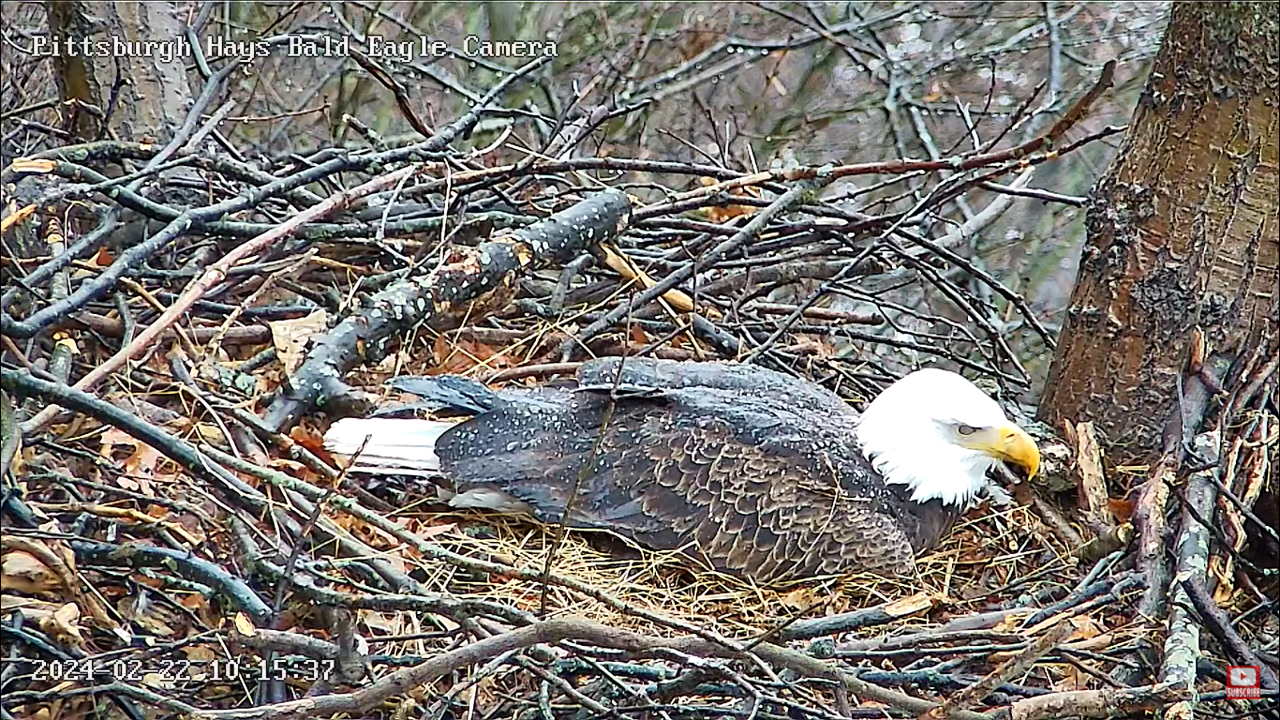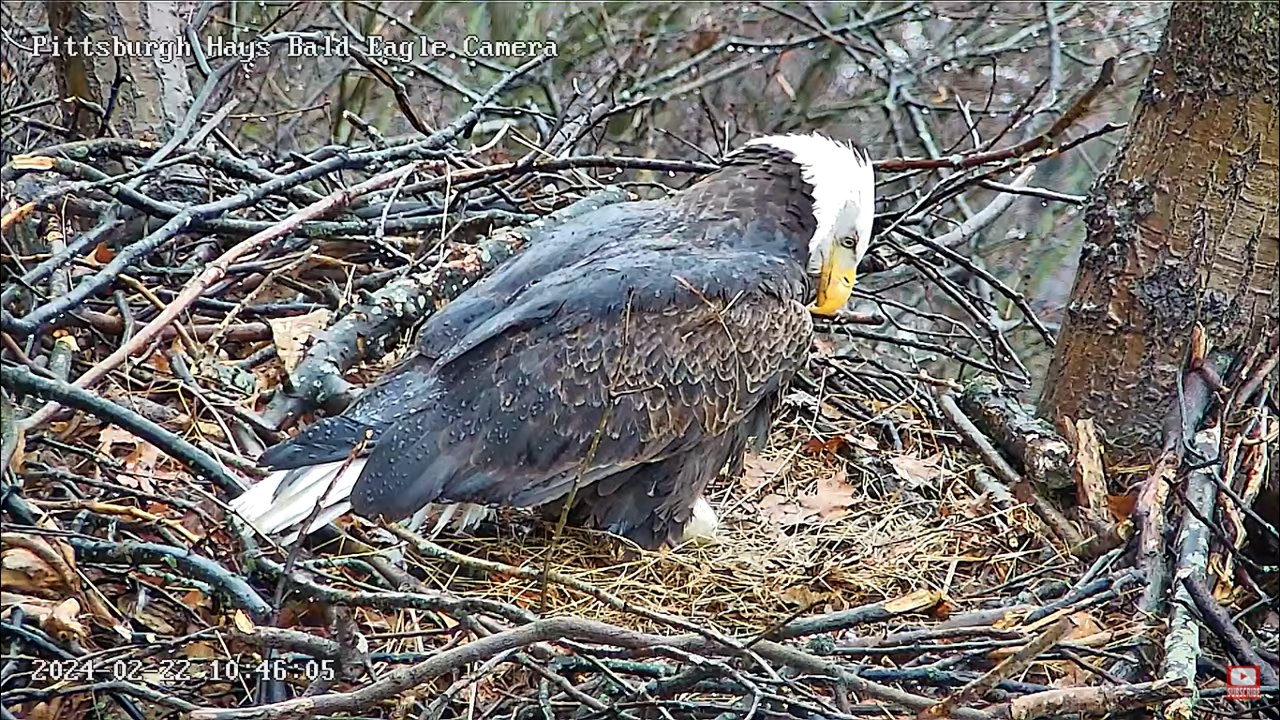Blog

#bioPGH Blog: Egg Watch!
 A resource of Biophilia: Pittsburgh, #bioPGH is a weekly blog and social media series that aims to encourage both children and adults to reconnect with nature and enjoy what each of our distinctive seasons has to offer.
A resource of Biophilia: Pittsburgh, #bioPGH is a weekly blog and social media series that aims to encourage both children and adults to reconnect with nature and enjoy what each of our distinctive seasons has to offer.
This Monday morning, I sat down at my desk and pulled up the Hays bald eagle nest camera. It was February 19, and I knew we were at the height of egg watch! In the past decade, the Hays pair had always laid their first egg sometime between February 12 and February 20. It had to be any day now! Dutifully, I checked in on the live stream throughout the day on Monday, then on Tuesday. When I came home from walking my dogs Tuesday evening, I saw the announcement: the first egg had been laid!
I was tuning into the livestream of a bald eagle’s nest in Hays Woods, just off Carson St and across the river from Hazelwood. The nest camera has been in place for a full decade now, and the nesting pair have become quite the celebrities, with viewers joining from all over the US and the rest of the world. The camera itself, a joint project between the Audubon Society of Western Pennsylvania (ASWP) and PixCams, an all-volunteer organization that manages education wildlife live cameras, provides a unique window into the wild world; and over the years, the story told from that window has been at times humorous, devastating, sobering and hopeful. Viewers have cheered on the eagles successfully defending their eggs from hungry racoons (video below) and mourned in other years when eggs weren’t viable. Overall, it has been a decade of unadulterated, authentic wild life.
A few things are different this year at the Hays nest, though, which could have delayed the usual timing of egg-laying. For starters, the male of the past decade is no longer present.
“The original male, who’d been a mate to the current female for over ten years, disappeared in early September [2023],” notes Rachel Handel of the Audubon Society of Western Pennsylvania (ASWP). “That’s not uncommon — the bird had to be at least five years old to be sexually mature, plus the 10 years he’s been with this mate means that he was on the older side of a wild Bald Eagle’s lifespan. A new male stepped in pretty soon afterward.”
Another possible disruption for the female was a pest last week. The livestream of the Hays nest has an online community with moderators who monitor the cameras. When I joined the chat on Monday, I learned that an intruder male bald eagle had persistently visited the nest last week, stressing the resident pair and sparking concern that his presence may have disrupted the resident female’s egg cycle.
As I waited on Monday for that first egg, I pulled up our local Audubon chapter’s website, to see the usual timing of egg laying (hence why I was surprised it hadn’t happened by Monday, February 19):
- 2023 First egg: February 17; second egg: February 20. First hatch: March 26; second hatch: March 28.
- 2022 First egg: February 11, Second egg: February 14, Third egg: February 17. First hatch: March 21; second hatch: March 22; third hatch: March 25. Fledges: June 10 and June 16.
- 2021 First egg: February 12, Second egg: February 15, Third egg: February 19. First hatch: March 23; second hatch: March 23; Third hatch: March 27. Fledges: June 6, June 12, and June 23.
- 2020 First egg: February 13, Second egg: February 16. First hatch: March 21, second hatch: March 23.
- 2019 First egg: February 12, Second egg: February 15, Third egg: February 18. First hatch: March 23; second hatch: March 25 (one egg not viable). Fledges: June 11 and June 16.
- 2018 First egg: February 13; Second egg: February 15, Third egg: February 19. One egg cracked, not viable. First hatch: March 23. Fledge: June 11.
- 2017 First egg: February 20. Hatch: March 29. Fledge: June 15.
- 2016 First egg: February 13; Second egg: February 16; Third egg: February 20. First hatch: March 21, Second hatch: March 22; Third egg not viable.
- 2015 First egg: February 17; Second egg: February 20. First egg broken: March 13. Second egg broken: March 27. Unsuccessful nesting season.
- 2014 First egg: February 19. Second egg: February 22. Third egg: February 25. First hatch: March 28. Second hatch: March 30. Third hatch: April 2. Fledge dates: June 20, 21, and 27.
- 2013 (no webcam) Incubating behavior by parents: March 11. Hatch behavior: April 14. Eaglet seen in the nest on May 13. Fledge: June 9.
Quoted from http://www.aswp.org/pages/nest-info-by-year, accessed 19 Feb 2024.
And notably, 2017 was the year that Hays nest blew down in a windstorm overnight February 12-13. The still managed to fledge at least one chick, though, with their only egg of the season laid on February 20 of that year.
That kind of resilience, though, really is the famous hallmark of the species. In 1963, only 487 nesting pairs of bald eagles were left throughout the entire Lower 48 states. A century of hunting, persecution and detrimental pesticide use had crippled their populations from the thousands (more likely hundreds of thousands) into this small few scattered about the country. Yet when the situation seemed most dire, the tides began to turn. A series of legislative actions, including the ban of the pesticide DDT and the bald eagle’s addition to Endangered Species List, set the stage for game managers, biologists, and ornithologists all over the country to begin one of the US’s most dramatic and encouraging restoration stories. By 2007, the number of nesting pairs in the Lower 48 had reached nearly 10,000, and those numbers have increased every year. In Pennsylvania alone, there were only 25 nesting pairs in 1998; today, we have around 300!
But now there is at least one egg in the nest as of posting time on Thursday, Feb. 22, and we will soon see if more eggs are to come. Bald eagle eggs are often laid 2-3 days apart (and this female in particular has been pretty consistent with three days), so the waiting game continues! In the meantime, I’m excited for the first one!
As an aside...

Notice how Mom's eyes look cloudy here? I accidentally took a screenshot as she blinked her nictitating membrane, a clear extra eyelid that can either protect eyes or moisten eyeballs.

Mom checking on the first egg. I am particularly curious about the timing and sex of subsequent eggs because that will play a major role in the chicks' survival. Since eggs are laid a few days apart, the chicks can each hatch a few days apart, and only a few days of growth can create a significant size difference in the chicks. On top of that, female birds of prey are usually larger than males. If, let's say, the first egg is a female and the last egg is a male, and they hatch 4-6 days apart, that female will have a tremendous headstart and could even outcompete her brother for food from the parents!
Wild video from a previous year of Mom feeding catfish eyeballs to the babies.
All eagle photos and footage are from the Hays webcam. The Hays webcam is a collaborative project between PixCams and Audubon Society of Western Pennsylvania. This live video feed has been granted a Special Permit by the Pennsylvania Game Commission for educational purposes. Header photo is public domain.

